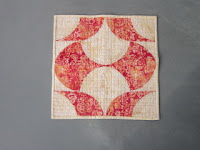I love Quilting Retreats. It is a time to spend several days with no interruptions for home responsibilities. Meals are planned and served and I don't have to do the clean up. No laundry is staring me in the face. And I can sew for hours and hours.
Each retreat presents me with the conundrum of what do I want to work on. I always take more projects than I could possibly ever do in the period of time allotted.
This past retreat came just in time for the Snowflake Quilt A Long from the Bernina USA blog page. It was designed and written by Faith Jones of Fresh Lemons Quilts blog. I love her work!
I cut all of my quilt pieces before I left so all I had to do was sew. I finished the top while I was there and then got it quilted and bound within a couple days of coming home.
 Here are the things I especially love about this quilt. First of all, the combination of red and aqua with the silver background was just so wintry crisp. It has no border and the blocks "float".
Here are the things I especially love about this quilt. First of all, the combination of red and aqua with the silver background was just so wintry crisp. It has no border and the blocks "float".
I quilted it in a medium meander with a silver thread.
The best part was the faux piping with binding that I added. That was a super technique.
I will show you how I did that Faux Piping. Some quilters call this a flange binding, but I think of flange as a different technique.
The first step is to cut the binding strips. You need one fabric that will make the piping and the other fabric will be the contrast.
Cut the piping fabric at 1 3/4" wide and cut the contrast fabric at 1 3/8" wide.
You will need enough strips to go all around your quilt (perimeter) just as you would in a regular binding technique. Go ahead and sew these strips end to end to get the proper length. I usually sew these on a diagonal to reduce bulk.
The next step will be to sew these two long strips together side by side.
I press this seam under the wider fabric. I find that makes it smoother for attaching.
Continue the process by folding this strip in half and pressing firmly. At this point I use a little spray starch to give a very sharp edge to the faux piping.
This is very important: Be careful that you are matching the edges of these two sides so that your piping is even.
Attaching this to your quilt is simple. The difference from the usual attachment of a French fold binding is that this one is attached to the back of the quilt first. This technique is a machine sewn binding on both back and front.
After attaching to the back of the quilt, bring the binding strip to the front being careful to keep everything straight. You may choose to pin the binding to the front side. My personal preference is to glue baste. I learned this technique from Sharon Schamber (www.sharonschamber.com) and it is the easiest way to work the mitered corners.
Stitch in the ditch next to the piping edge with a thread that matches the contrast fabric. In my example, that thread color is silver to match my Kona Silver fabric.
Making the mitered corners is very smooth. Just take your time and make sure that you get a good perpendicular fold at the corner to bring the fabric into place.
This is a great finishing technique for any quilt you do. I am using this more and more on my quilts so I can get more quilts finished.
-sandi

















































